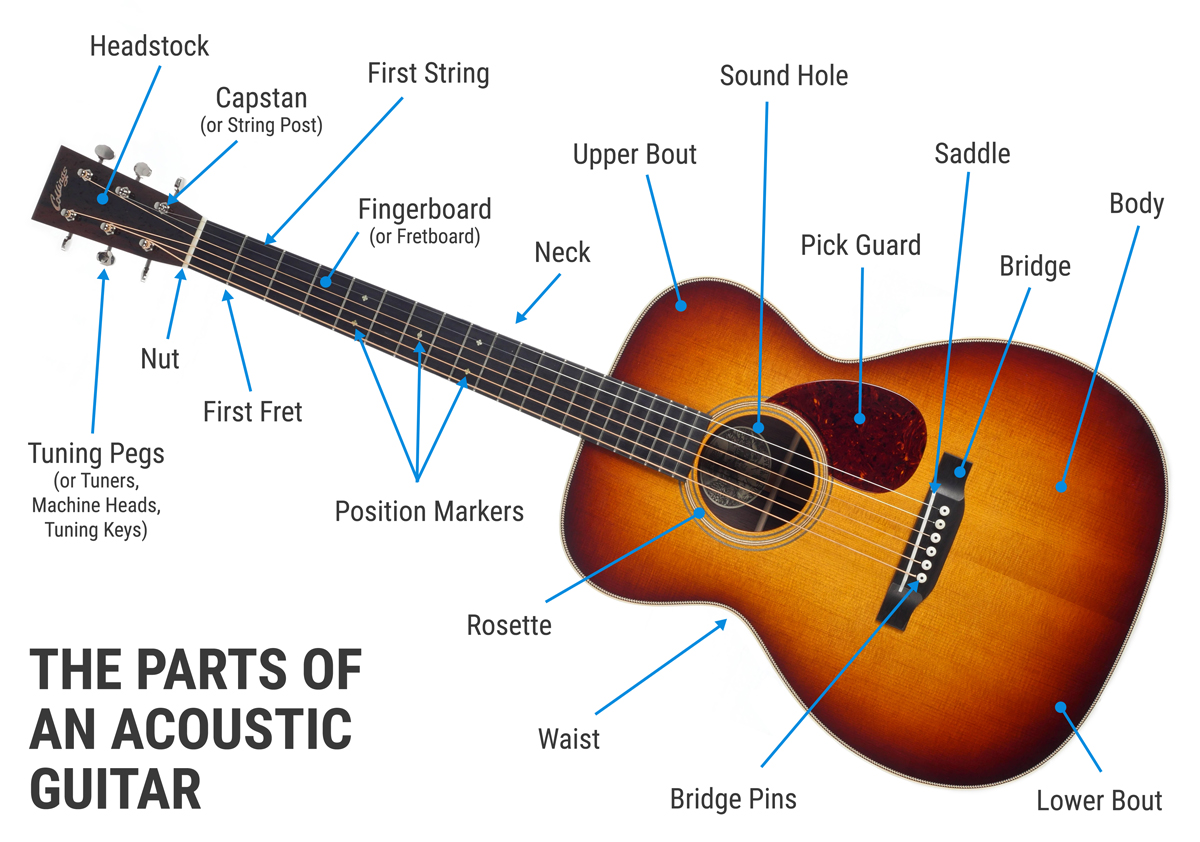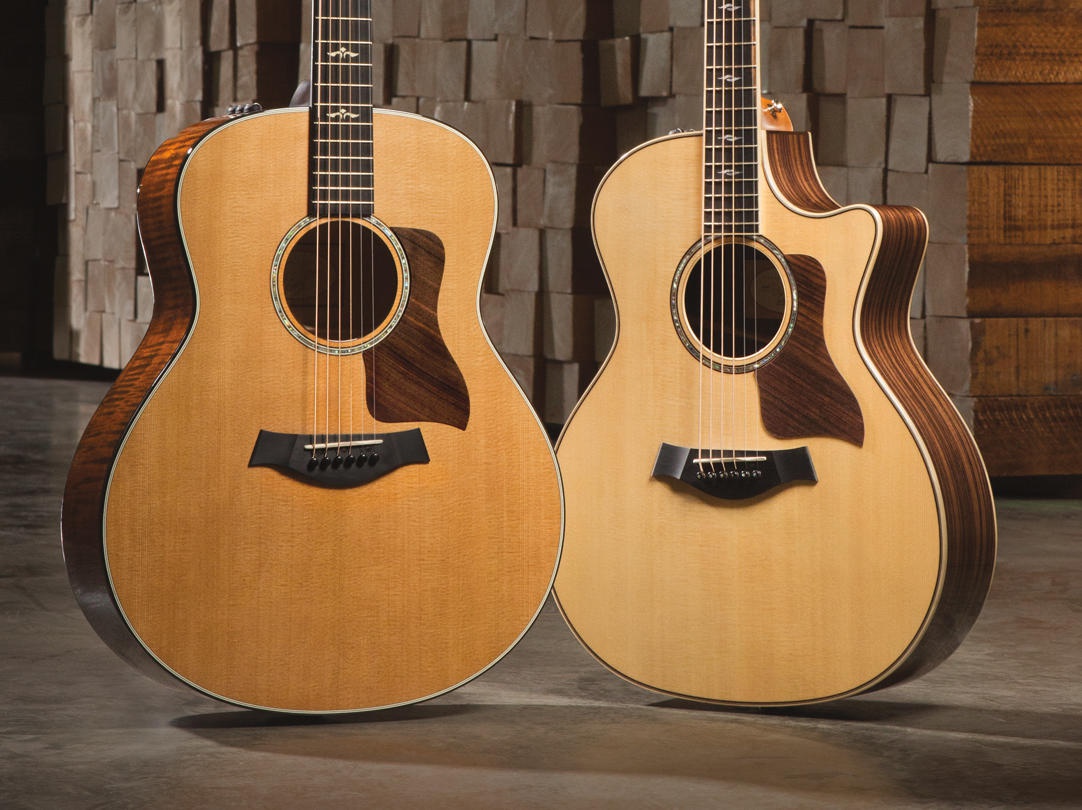  
|
 sections on this page
sections on this page Parts of the guitar
Parts of the guitar  Different body shapes
Different body shapes |
 The basics of acoustic guitars
The basics of acoustic guitars Parts Of The Guitar
Parts Of The Guitar
The headstock, found at the very top of the guitar, maintains the tension and tuning of the strings through the tuning pegs found on it. Headstock design is largely up to your own taste, but its shape does affect playability. A straight headstock, or flat headstock, where all the tuning pegs are in a straight line is simple and easy to tune (see Fender Stratocaster). However, it can make the tuning less stable and cause string slippage which leads to fret buzz. The 3x3 design, where one side of the headstock holds three tuning pegs while the other holds the other three, is just as common (see Gretsch Duo Jet). The 3x3 design fixes the tuning issues of the straight headstock with the only issue being that many people consider it to be less visually appealing than other headstock designs. Some guitars do away with headstocks entirely, but those are significantly more difficult to restring (see Strandberg Boden Standard). On acoustics, the vast majority of headstocks are in the 3x3 style. The tuning pegs, also called machine heads, are where you tune the guitar. The pegs have a hold going through them which the strings run through before wrapping around the peg. Turning the peg clockwise increases the string tension which increases the pitch, turning the peg counterclockwise does the opposite. The two main types of tuners are standard tuners and locking tuners. Standard tuners work the same way I have described but locking tuners do not require that you wind the string around it. Instead, the tuner clamps down on the string, holding it in place. This makes string changes faster and easier while also making the tuning more stable. The neck is what connects the headstock to the body and where you will hold the guitar when you play. Necks can come in different shapes, lengths, and widths. The most common shapes are C shape, U shape, D shape, and V shape. It's up to your own personal taste which neck type is better, so experiment with whatever feels best in your hands. The fretboard, also called a fingerboard, lies on top of the guitar neck. It's a long flat piece of material, typically wood, that is divided into sections called frets. The frets determine the pitch of the notes when pressed. Typically, there are marks on the fretboard for the 3rd, 5th, 7th, 9th, and 12th frets, usually one dot on each with two dots on the 12th. The strings are an important part of the guitar's sound. There are two main types, nylon and steel. Nylon strings have a more plucky and lighter sound while steel strings have more of a boom to them with a deeper tone. They both can come in a variety of sizes that affect how they sound and hard they are to press. Thinner strings are easier on the fingers and have a lighter sound, but can break more often. Larger strings are harder to press and have a deeper sound, and break less often. Ultimately it's up to what sound you like and what's easiest to play. The body is the main part of the acoustic guitar. They are hollow inside and their shape and size determine their sound. When the strings are plucked or strummed the sound reverberates throughout the body, amplifying it. The sound eventually leaves through the sound hole, which is the small hole around the center of the guitar. The pickguard is the material at the side of the sound hole. Its purpose is to protect the guitar's finish from being damaged by your picking hand or guitar pick. Whether-or-not this is an actual problem however, is mainly up to how you play. For many players pickguards are more for the look of the guitar rather than any actual purpose, and many guitars don't have them. The bridge is the small stump at the bottom of the guitar. The strings are run through holes in the bridge and are tied so they don't slip out and can be tightened and played.  Different Body Shapes
Different Body Shapes
The Parlor guitar is the smallest size acoustic guitar. They have a light and balanced sound, and are typically played fingerstyle. The Concert model, or model "O", guitars are slightly larger than parlor guitars but are also known for their balanced sound but this time with a little more bass than the parlor. They are also typically played fingerstyle. The Grand Concert model, or model "OO", is a sort of transition spot between the sweet brighter tones of the parlor and O and the deep boom of the dreadnought and jumbo. An overall solid mid-range guitar. The Orchestra Model, or model "OOO", is similar to the OO with it being a mid-range focused guitar but this time with a little more focus on the bass and boom. The Dreadnought is the most famous and popular style of acoustic guitar. They are large body acoustics known for their deep bass, high sustain, and loud volume. They are incredibly versatile guitars and are used in anything from bluegrass to pop. The Jumbo is the biggest acoustic guitar. Like the dreadnought they are known for their booming bass and loud volume. They are typically used in country music. 
You may have seen that some guitars have a slope on one side of their body near the neck, this is called a cutaway. Cutaways are meant to make it easier for players to reach the bottom frets on the neck. However, since they cut into the body they do impact the guitars resonance and tone, but it's very minor and can be ignored by most players. The majority of acoustic guitars with cutaways only have one, but they can come with two with one cut on each side of the neck. Double cutaways are far more common on electric guitars than acoustics. 
|
|
|
